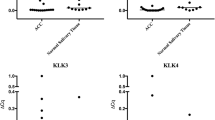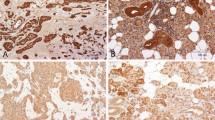Abstract
The human kallikrein 8 protein (KLK8) is expressed in many normal tissues including esophagus, skin, testis, tonsil, kidney, breast, and salivary gland, and is found in biological fluids including breast milk, amniotic fluid, seminal fluid and serum. It has also been shown to be a biomarker and prognostic factor for breast cancer. The aim of this study was to determine whether KLK8 is expressed in salivary gland tissues and salivary gland tumors (both benign and malignant), in order to compare normal with tumor tissues. Pleomorphic adenomas, adenoid cystic carcinomas, polymorphous low grade adenocarcinomas, acinic cell carcinomas, mucoepidermoid carcinomas, and adenocarcinomas NOS of both minor and major salivary glands were examined. The results of this study indicate that most salivary gland tumors show high levels of expression of KLK8.





Similar content being viewed by others
Abbreviations
- PA:
-
Pleomorphic adenoma
- ACC:
-
Adenoid cystic carcinoma
- PLGA:
-
Polymorphous low grade adenocarcinoma
- ACI:
-
Acinic cell carcinoma
- MEC:
-
Mucoepidermoid carcinoma
- ANOS:
-
Adenocarcinoma not otherwise specified
- KLK:
-
Human kallikrein protein
- KLK :
-
Human kallikrein gene
- RT:
-
Room temperature
- PBS:
-
Phosphate-buffered saline
- Pab:
-
Polyclonal antibody
- DAB:
-
3,3′-Diaminobenzidine
References
Diamandis EP, Yousef GM, Luo LY. The human kallikrein gene family—implications in carcinogenesis. Trends Endocrinol Metab. 2000;11:54–60.
Yousef GM, Diamandis EP. The new human tissue kallikrein gene family: structure, function and association to disease. Endocr Rev. 2001;22:184–204.
Borgono CA, Michael IP, Diamandis EP. Human tissue kallikreins: physiologic roles and applications in cancer. Mol Cancer Res. 2004;2:257–80.
Borgono CA, Diamandis EP. The emerging roles of human tissue kallikreins in cancer. Nat Rev Cancer. 2004;4:876–90.
Yousef GM, Diamandis EP. Human tissue kallikreins: a new enzymatic cascade pathway? Biol Chem. 2002;383:1045–57.
Rajapakse S, Ogiwara K, Takano N, et al. Biochemical characterization of human kallikrein 8 and its possible involvement in the degradation of extracellular matrix proteins. FEBS Lett. 2005;579:6879–84.
Diamandis EP, Yousef GM. Human tissue kallikreins: a family of new cancer biomarkers. Clin Chem. 2002;48:1198–1205.
Diamandis EP, Yousef GM. Human tissue kallikrein gene family: a rich source of novel disease biomarkers. Expert Rev Mol Diagn. 2001;1:182–90.
Obiezu C, Diamandis E. Human tissue kallikrein family: applications in cancer. Cancer Lett. 2005;224:1–22.
Petraki CD, Papanastasiou PA, Karavana VN, et al. Cellular distribution of human tissue kallikreins: immunohistochemical localization. Biol Chem. 387;2006:653–63.
Yoshida S, Taniguchi M, Hirata A, et al. Sequence analysis and expression of human neuropsin cDNA and gene. Gene. 1998;213:9–16.
Kishi T, Grass L, Soosaipillai A, et al. Human kallikrein 8: immunoassay development and identification in tissue extracts and biological fluids. Clin Chem. 2003;49:87–96.
Ellis GL, Auclair PL. Tumors of the salivary glands. In: Rosai J, Sobin LH, editors. Atlas of tumor pathology, Third Series, Fascicle 17. Washington, D.C.: Armed Forces Institute of Pathology; 1996. p. 39–56, 155–228.
Black MH, Magklara A, Obiezu CV, et al. Development of an ultrasensitive immunoassay for human glandular kallikrein with no cross-reactivity from prostate-specific antigen. Clin Chem. 1999;45:790–9.
Allred DC, Clark GM, Elledge R, et al. Association of p53 protein expression with tumor cell proliferation rate and clinical outcome in node-negative breast cancer. J Natl Cancer Inst. 1993;85:200–6.
Tuck AB, O’Malley FP, Singhal H, et al. Osteopontin expression in a group of lymph node negative breast cancer patients. Int J Cancer. 1998;79:502–8.
Kishi T, Grass L, Soosaipillai A, et al. Human kallikrein 8, a novel biomarker for ovarian carcinoma. Cancer Res. 2003;63:2771–4.
Yousef GM, Polymeris ME, Yacoub GM, et al. Parallel overexpression of seven kallikrein genes in ovarian cancer. Cancer Res. 2003;63:2223–7.
Magklara A, Scorilas A, Katsaros D, et al. The human KLK8 (neuropsin/ovasin) gene: identification of two novel splice variants and its prognostic value in ovarian cancer. Clin Cancer Res. 2001;7:806–11.
Shigemasa K, Tian X, Gu L, et al. Human kallikrein 8 (KLK8/TADG-14) expression is associated with an early clinical stage and favorable prognosis in ovarian cancer. Oncol Rep. 2004;11:1153–9.
Borgono CA, Kishi T, Scorilas A, et al. Human kallikrein 8 protein is a favorable prognostic marker in ovarian cancer. Clin Cancer Res. 2006;12:1487–93.
Yousef GM, Yacoub GM, Polymeris ME, et al. Kallikrein gene downregulation in breast cancer. Br J Cancer. 2004;90:167–72.
Paliouras M, Diamandis EP. Coordinated steroid hormone-dependent and independent expression of multiple kallikreins in breast cancer cell lines. Breast Cancer Res Treat. 2007;102:7–18.
Cané S, Bignotti E, Bellone S, et al. The novel serine protease tumor-associated differentially expressed gene-14(KLK8/Neuropsin/Ovasin) is highly overexpressed in cervical cancer. Am J Obstet Gynecol. 2004;190:60–6.
Jin H, Nagai N, Shigemasa K, et al. Expression of tumor-associated differentially expressed Gene-14 (TADG-14/KLK8) and its protein KLK8 in uterine endometria and endometrial carcinomas. Tumour Biol. 2006;27:274–82.
Sher YP, Chou CC, Chou RH, et al. Human kallikrein 8 protease confers a favorable clinical outcome in non-small cell lung cancer by suppressing tumor cell invasiveness. Cancer Res. 2006;66:11763–70.
Kishi T, Cloutier SM, Kundig C, et al. Activation and enzymatic characterization of recombinant human kallikrein 8. Biol Chem. 2006;387:723–31.
Pampalakis G, Sotiropoulou G. Tissue kallikrein proteolytic cascade pathways in normal physiology and cancer. Biochim Biophys Acta. 2007;1776:22–31.
Emami N, Diamandis EP. Human tissue kallikreins: a road under construction. Clin Chim Acta. 2007;381:78–84.
Yoon H, Laxmikanthan G, Lee J, et al. Activation profiles and regulatory cascades of the human kallikrein-related peptidases. J Biol Chem. 2007;282:31852–64.
Darling MR, Jackson-Boeters L, Daley TD, et al. Human kallikrein 6 expression in salivary gland tumors. J Histochem Cytochem. 2006;54:337–42.
Darling MR, Jackson-Boeters L, Daley TD, et al. Human kallikrein 13 expression in salivary gland tumors. Int J Biol Markers. 2006;21:106–10.
Darling MR, Tsai S, Jackson-Boeters L, et al. Human kallikrein 3 (prostate specific antigen) and human kallikrein 5 expression in salivary gland tumors. Int J Biol Markers. 2006;21:201–5.
Paliouras M, Diamandis EP. The kallikrein world: an update on the human tissue kallikreins. Biol Chem 2006;387:643–52.
Acknowledgments
The authors are grateful to Linda Grass for technical advice and to the National Organization for Rare Disorders which provided funding for this study.
Author information
Authors and Affiliations
Corresponding author
Rights and permissions
About this article
Cite this article
Darling, M.R., Tsai, S., Jackson-Boeters, L. et al. Human Kallikrein 8 Expression in Salivary Gland Tumors. Head and Neck Pathol 2, 169–174 (2008). https://doi.org/10.1007/s12105-008-0068-z
Received:
Accepted:
Published:
Issue Date:
DOI: https://doi.org/10.1007/s12105-008-0068-z




